All Exams >
Bank Exams >
IBPS PO Prelims & Mains Preparation >
All Questions
All questions of Syllogism for Bank Exams Exam
Two statements are given followed by two conclusions numbered I and II. Assuming the statements to be true, even if they seem to be at variance with commonly known facts, decide which of the conclusions logically follow(s) from the statements.Statements:Some horses are not trucks.All horses are white.Conclusions:I. Some white are trucks.II. Some horses being truck is a possibility.- a)Only conclusion I follows
- b)Neither conclusion I nor II follows
- c)Only conclusion II follows
- d)Both conclusions I and II follow
Correct answer is option 'C'. Can you explain this answer?
Two statements are given followed by two conclusions numbered I and II. Assuming the statements to be true, even if they seem to be at variance with commonly known facts, decide which of the conclusions logically follow(s) from the statements.
Statements:
Some horses are not trucks.
All horses are white.
Conclusions:
I. Some white are trucks.
II. Some horses being truck is a possibility.
a)
Only conclusion I follows
b)
Neither conclusion I nor II follows
c)
Only conclusion II follows
d)
Both conclusions I and II follow

|
EduRev CLAT answered |
The least possible Venn diagram is:
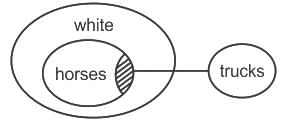
Conclusions:
I. Some white are trucks. → Not follow (As, there is no definite relation between white and trucks. Hence, false)
II. Some horses being truck is a possibility. → Follows (As, some horses are trucks is not definite, but it can be possible)
Hence, the correct answer is "Only conclusion II follows".
Statements: All the phones are scales. All the scales are calculators.Conclusions: - All the calculators are scales.
- All the phones are calculators
- All the scales are phones.
- Some calculators are phones.
- a)Only (1) and (4)
- b)Only (3) and (4)
- c)Only (2) and (4)
- d)Only (1) and (2)
- e)Only (1) and (3
Correct answer is option 'C'. Can you explain this answer?
Statements: All the phones are scales. All the scales are calculators.
Conclusions:
- All the calculators are scales.
- All the phones are calculators
- All the scales are phones.
- Some calculators are phones.
a)
Only (1) and (4)
b)
Only (3) and (4)
c)
Only (2) and (4)
d)
Only (1) and (2)
e)
Only (1) and (3

|
Tarun Nambiar answered |
Statements: All the research scholars are psychologists. Some psychologists are scientists.
Conclusions:
- All the research scholars are scientists.
- Some research scholars are scientists.
- Some scientists are psychologists.
- Some psychologists are research scholars.
- a)Only (3) and (4)
- b)Only (3)
- c)Only (2) and (4)
- d)All the four
- e)None of the four
Correct answer is option 'A'. Can you explain this answer?
Statements: All the research scholars are psychologists. Some psychologists are scientists.
Conclusions:
- All the research scholars are scientists.
- Some research scholars are scientists.
- Some scientists are psychologists.
- Some psychologists are research scholars.
a)
Only (3) and (4)
b)
Only (3)
c)
Only (2) and (4)
d)
All the four
e)
None of the four
|
|
Lavisha Tak answered |
Option D should be correct not option A
Statement 1: All chickens are birds.
Statement 2: Some chickens are hens.
Statement 3: Female birds lay eggs.If the above statement are facts, then which of the following must also be a fact?
I. All birds lay eggs.
II. Hens are birds.
III. Some chickens are not hens.- a)II only
- b)II and III only
- c)I, II and III
- d)None of the statement is a known fact
Correct answer is option 'D'. Can you explain this answer?
Statement 1: All chickens are birds.
Statement 2: Some chickens are hens.
Statement 3: Female birds lay eggs.
Statement 2: Some chickens are hens.
Statement 3: Female birds lay eggs.
If the above statement are facts, then which of the following must also be a fact?
I. All birds lay eggs.
II. Hens are birds.
III. Some chickens are not hens.
I. All birds lay eggs.
II. Hens are birds.
III. Some chickens are not hens.
a)
II only
b)
II and III only
c)
I, II and III
d)
None of the statement is a known fact

|
Glance Learning Institute answered |
Statements I and II can be represented as venn diagrams in the following ways:
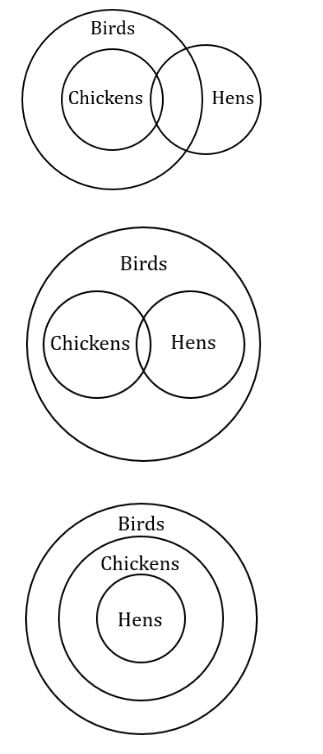
As ‘Female birds lay eggs’, so ‘All birds lay eggs’ is incorrect.
Conclusion ‘Hens are Birds’ may or may not be true as can be seen from the Venn diagrams.
Conclusion ‘Some chickens are not hens’ is also not definitely true as can be seen from the third Venn diagram.
Hence, option (d).
Statements: All the books are pencils. No pencil is eraser.Conclusions: - All the pencils are books.
- Some erasers are books.
- No book is eraser.
- Some books are erasers.
- a)Only (3)
- b)Only (1) and (3)
- c)Only (1) and (2)
- d)Only (2) and (3)
- e)Only (3) and (4)
Correct answer is option 'A'. Can you explain this answer?
Statements: All the books are pencils. No pencil is eraser.
Conclusions:
- All the pencils are books.
- Some erasers are books.
- No book is eraser.
- Some books are erasers.
a)
Only (3)
b)
Only (1) and (3)
c)
Only (1) and (2)
d)
Only (2) and (3)
e)
Only (3) and (4)

|
Sameer Yadav answered |
Statements: All men are vertebrates. Some mammals are vertebrates.Conclusions: - All men are mammals.
- All mammals are men.
- Some vertebrates are mammals.
- All vertebrates are men.
- a)Only (4)
- b)Only (2)
- c)Only (3)
- d)Only (1)
- e)Only (1) and (3)
Correct answer is option 'C'. Can you explain this answer?
Statements: All men are vertebrates. Some mammals are vertebrates.
Conclusions:
- All men are mammals.
- All mammals are men.
- Some vertebrates are mammals.
- All vertebrates are men.
a)
Only (4)
b)
Only (2)
c)
Only (3)
d)
Only (1)
e)
Only (1) and (3)

|
Nitin Mehra answered |
Directions to Solve In each of the following questions two statements are given and these statements are followed by two conclusions numbered (1) and (2). You have to take the given two statements to be true even if they seem to be at variance from commonly known facts. Read the conclusions and then decide which of the given conclusions logically follows from the two given statements, disregarding commonly known facts.Give answer: - (A) If only (1) conclusion follows
- (B) If sonly (2) conclusion follows
- (C) If either (1) or (2) follows
- (D) If neither (1) nor (2) follows and
- (E) If both (1) and (2) follow.
Question - Statements: Some cows are crows. Some crows are elephants. Conclusions: - Some cows are elephants.
- All crows are elephants.
- a)Only (1) conclusion follows
- b)Only (2) conclusion follows
- c)Either (1) or (2) follows
- d)Neither (1) nor (2) follows
- e)Both (1) and (2) follow
Correct answer is option 'D'. Can you explain this answer?
Directions to Solve
In each of the following questions two statements are given and these statements are followed by two conclusions numbered (1) and (2). You have to take the given two statements to be true even if they seem to be at variance from commonly known facts. Read the conclusions and then decide which of the given conclusions logically follows from the two given statements, disregarding commonly known facts.
Give answer:
- (A) If only (1) conclusion follows
- (B) If sonly (2) conclusion follows
- (C) If either (1) or (2) follows
- (D) If neither (1) nor (2) follows and
- (E) If both (1) and (2) follow.
Statements: Some cows are crows. Some crows are elephants.
Conclusions:
- Some cows are elephants.
- All crows are elephants.
a)
Only (1) conclusion follows
b)
Only (2) conclusion follows
c)
Either (1) or (2) follows
d)
Neither (1) nor (2) follows
e)
Both (1) and (2) follow

|
Ameya Dey answered |
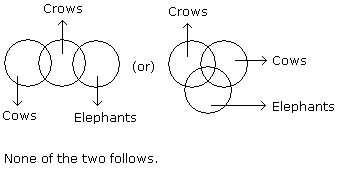
Each of the questions below starts with a few statements, followed by four conclusions numbered 1, 2, 3 and 4. You have to consider every given statement as true, even if it does not conform to the accepted facts. Read the conclusions carefully and then decide which of the conclusion(s) logically follow(s) from the given statements, disregarding commonly known facts.
Statements:
a. Some boys are scholars
b. Some teachers are boys
c. All scholars are observers
Conclusions:
1. Some scholars are boys
2. Some scholars are not boys
3. Some observers are boys
4. Some teachers are scholars
- a)1, and 3 follow
- b)1, 3, and 4 follow
- c)Either 1 or 2 and 3 follow
- d)None of the above
Correct answer is option 'A'. Can you explain this answer?
Each of the questions below starts with a few statements, followed by four conclusions numbered 1, 2, 3 and 4. You have to consider every given statement as true, even if it does not conform to the accepted facts. Read the conclusions carefully and then decide which of the conclusion(s) logically follow(s) from the given statements, disregarding commonly known facts.
Statements:
a. Some boys are scholars
b. Some teachers are boys
c. All scholars are observers
b. Some teachers are boys
c. All scholars are observers
Conclusions:
1. Some scholars are boys
2. Some scholars are not boys
3. Some observers are boys
4. Some teachers are scholars
2. Some scholars are not boys
3. Some observers are boys
4. Some teachers are scholars
a)
1, and 3 follow
b)
1, 3, and 4 follow
c)
Either 1 or 2 and 3 follow
d)
None of the above

|
Glance Learning Institute answered |
Answer: Option A
Some boys are scholars:
There are two possible deductions from this statement.
i) All scholars are boys (i.e. the set of scholars is a subset of boys)
ii) Some scholars are boys (i.e. the intersection of the sets of scholars and boys is not a null set)
ii) Some scholars are boys (i.e. the intersection of the sets of scholars and boys is not a null set)
Some teachers are boys
There are two possible deductions from this statement.
i) All boys are teachers (i.e. the set of boys is a subset of teachers)
ii) Some boys are teachers (i.e. the intersection of the sets of teachers and boys is not a null set)
i) All boys are teachers (i.e. the set of boys is a subset of teachers)
ii) Some boys are teachers (i.e. the intersection of the sets of teachers and boys is not a null set)
All scholars are observers.
There are two possible deductions from this statement.
i) All observers are scholars (i.e. the set of observers and scholars are identical)
ii) Some observers are scholars (i.e. the set of observers is a subset of scholars)
i) All observers are scholars (i.e. the set of observers and scholars are identical)
ii) Some observers are scholars (i.e. the set of observers is a subset of scholars)
Let us analyze the conclusions:
1) Some scholars are boys.This is true for both the cases that have been mentioned above,
2) Some scholars are not boysThis may or may not be true because there are chances that all scholars may also be boys.
3) Some observers are boys.We know that either all or some observers are scholars (i.e. the set of observers is definitely a subset of the set of scholars) and the intersection of the sets of scholars and boys is not a null set. This means that some observers will always be boys. Hence conclusion 3 is true.
4) Some teachers are scholars.The intersection of set of boys and scholars is not a null set and the intersection of set of boys and teachers is not a null set. But this doesn’t mean that the intersection of boys and teachers will also be a null set. There may or may not be some teachers who are scholars.
Thus this statement is incorrect.
2) Some scholars are not boysThis may or may not be true because there are chances that all scholars may also be boys.
3) Some observers are boys.We know that either all or some observers are scholars (i.e. the set of observers is definitely a subset of the set of scholars) and the intersection of the sets of scholars and boys is not a null set. This means that some observers will always be boys. Hence conclusion 3 is true.
4) Some teachers are scholars.The intersection of set of boys and scholars is not a null set and the intersection of set of boys and teachers is not a null set. But this doesn’t mean that the intersection of boys and teachers will also be a null set. There may or may not be some teachers who are scholars.
Thus this statement is incorrect.
Statements: All green are blue. All blue are white.Conclusions: - Some blue are green.
- Some white are green.
- Some green are not white.
- All white are blue.
- a)Only (1) and (2)
- b)Only (1) and (3)
- c)Only (1) and (4)
- d)Only (2) and (4)
Correct answer is option 'A'. Can you explain this answer?
Statements: All green are blue. All blue are white.
Conclusions:
- Some blue are green.
- Some white are green.
- Some green are not white.
- All white are blue.
a)
Only (1) and (2)
b)
Only (1) and (3)
c)
Only (1) and (4)
d)
Only (2) and (4)

|
Parth Joshi answered |
Directions to Solve In each of the following questions two statements are given. Which are followed by four conclusions (1), (2), (3) and (4). Choose the conclusions which logically follow from the given statements. Question - Statements: No door is dog. All the dogs are cats. Conclusions: - No door is cat.
- No cat is door.
- Some cats are dogs.
- All the cats are dogs.
- a)Only (2) and (4)
- b)Only (1) and (3)
- c)Only (3) and (4)
- d)Only (3)
- e)All the four
Correct answer is option 'D'. Can you explain this answer?
Directions to Solve
In each of the following questions two statements are given. Which are followed by four conclusions (1), (2), (3) and (4). Choose the conclusions which logically follow from the given statements.
Question - Statements: No door is dog. All the dogs are cats.
Conclusions:
- No door is cat.
- No cat is door.
- Some cats are dogs.
- All the cats are dogs.
a)
Only (2) and (4)
b)
Only (1) and (3)
c)
Only (3) and (4)
d)
Only (3)
e)
All the four

|
Debanshi Saha answered |
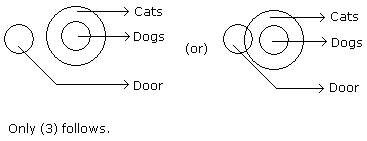
Each of the questions below starts with a few statements, followed by four conclusions numbered 1, 2, 3 and 4. You have to consider every given statement as true, even if it does not conform to the accepted facts. Read the conclusions carefully and then decide which of the conclusion(s) logically follow(s) from the given statements, disregarding commonly known facts.Statements:a. All teachers are professors
b. All professors are researchers
c. All researchers are consultantsConclusions:1. Some consultants are teachers
2. All professors are consultants
3. Some researchers are teachers
4. All professors are teachers- a)Only 1 and 2 follow
- b)Only 1 and 3 follow
- c)Either 1 or 4 follow
- d)None of the above
Correct answer is option 'D'. Can you explain this answer?
Each of the questions below starts with a few statements, followed by four conclusions numbered 1, 2, 3 and 4. You have to consider every given statement as true, even if it does not conform to the accepted facts. Read the conclusions carefully and then decide which of the conclusion(s) logically follow(s) from the given statements, disregarding commonly known facts.
Statements:
a. All teachers are professors
b. All professors are researchers
c. All researchers are consultants
b. All professors are researchers
c. All researchers are consultants
Conclusions:
1. Some consultants are teachers
2. All professors are consultants
3. Some researchers are teachers
4. All professors are teachers
2. All professors are consultants
3. Some researchers are teachers
4. All professors are teachers
a)
Only 1 and 2 follow
b)
Only 1 and 3 follow
c)
Either 1 or 4 follow
d)
None of the above
|
|
Samaira nayar answered |
Analysis:
All teachers are professors, all professors are researchers, and all researchers are consultants. We have to determine which conclusions logically follow from these given statements.
Conclusions:
1. Some consultants are teachers
This conclusion can be logically derived from the given statements. Since all teachers are professors, and all professors are researchers, which in turn are consultants, it is possible that some consultants are also teachers.
2. All professors are consultants
This conclusion cannot be logically derived from the given statements. While all professors are indeed researchers and consultants, it does not necessarily mean that all professors are consultants. The statements do not provide a direct link between professors and consultants.
3. Some researchers are teachers
This conclusion can be logically derived from the given statements. Since all professors are researchers, and all teachers are professors, it is possible that some researchers are also teachers.
4. All professors are teachers
This conclusion cannot be logically derived from the given statements. Although all teachers are professors, it does not mean that all professors are teachers. The statements only establish a one-way relationship between teachers and professors, not vice versa.
Therefore, only conclusions 1 and 3 logically follow from the given statements.
All teachers are professors, all professors are researchers, and all researchers are consultants. We have to determine which conclusions logically follow from these given statements.
Conclusions:
1. Some consultants are teachers
This conclusion can be logically derived from the given statements. Since all teachers are professors, and all professors are researchers, which in turn are consultants, it is possible that some consultants are also teachers.
2. All professors are consultants
This conclusion cannot be logically derived from the given statements. While all professors are indeed researchers and consultants, it does not necessarily mean that all professors are consultants. The statements do not provide a direct link between professors and consultants.
3. Some researchers are teachers
This conclusion can be logically derived from the given statements. Since all professors are researchers, and all teachers are professors, it is possible that some researchers are also teachers.
4. All professors are teachers
This conclusion cannot be logically derived from the given statements. Although all teachers are professors, it does not mean that all professors are teachers. The statements only establish a one-way relationship between teachers and professors, not vice versa.
Therefore, only conclusions 1 and 3 logically follow from the given statements.
Read the given statements and conclusions carefully. Assuming that the information given in the statements is true, even if it appears to be at variance with commonly known facts, decide which of the given conclusions logically follow(s) from the statements.Statements:No plate is a spoon.Some plates are forks.All forks are knives.Conclusions:I. Some plates are knives is a possibility.II. No spoon is a fork.- a)Only conclusion I follows
- b)Neither conclusion I nor II follows
- c)Both conclusions I and II follow
- d)Only conclusion II follows
Correct answer is option 'B'. Can you explain this answer?
Read the given statements and conclusions carefully. Assuming that the information given in the statements is true, even if it appears to be at variance with commonly known facts, decide which of the given conclusions logically follow(s) from the statements.
Statements:
No plate is a spoon.
Some plates are forks.
All forks are knives.
Conclusions:
I. Some plates are knives is a possibility.
II. No spoon is a fork.
a)
Only conclusion I follows
b)
Neither conclusion I nor II follows
c)
Both conclusions I and II follow
d)
Only conclusion II follows

|
EduRev CLAT answered |
Statement:
No plate is a spoon.
Some plates are forks.
All forks are knives.
The least possible diagram for the given statements is as follows:

Conclusions:
(i) Some plates are knives is a possibility - False (Some plates are forks and All forks are knives, so some plates are knives is definitely true).
(ii) No spoon is a fork - False (Because No direct relation given between them, so It can be possible not definite).
Here, Neither conclusion I nor II follows.
Hence, the correct answer is "Option 2".
Directions to Solve In each of the following questions two statements are given and these statements are followed by two conclusions numbered (1) and (2). You have to take the given two statements to be true even if they seem to be at variance from commonly known facts. Read the conclusions and then decide which of the given conclusions logically follows from the two given statements, disregarding commonly known facts.Give answer: - (A) If only (1) conclusion follows
- (B) If sonly (2) conclusion follows
- (C) If either (1) or (2) follows
- (D) If neither (1) nor (2) follows and
- (E) If both (1) and (2) follow.
Question - Statements: All the actors are girls. All the girls are beautiful. Conclusions: - All the actors are beautiful.
- Some girls are actors.
- a)Only (1) conclusion follows
- b)Only (2) conclusion follows
- c)Either (1) or (2) follows
- d)Neither (1) nor (2) follows
- e)Both (1) and (2) follow
Correct answer is option 'E'. Can you explain this answer?
Directions to Solve
In each of the following questions two statements are given and these statements are followed by two conclusions numbered (1) and (2). You have to take the given two statements to be true even if they seem to be at variance from commonly known facts. Read the conclusions and then decide which of the given conclusions logically follows from the two given statements, disregarding commonly known facts.
Give answer:
- (A) If only (1) conclusion follows
- (B) If sonly (2) conclusion follows
- (C) If either (1) or (2) follows
- (D) If neither (1) nor (2) follows and
- (E) If both (1) and (2) follow.
Statements: All the actors are girls. All the girls are beautiful.
Conclusions:
- All the actors are beautiful.
- Some girls are actors.
a)
Only (1) conclusion follows
b)
Only (2) conclusion follows
c)
Either (1) or (2) follows
d)
Neither (1) nor (2) follows
e)
Both (1) and (2) follow

|
Debanshi Saha answered |
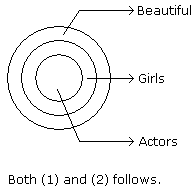
Directions to Solve In each of the following questions two statements are given and these statements are followed by two conclusions numbered (1) and (2). You have to take the given two statements to be true even if they seem to be at variance from commonly known facts. Read the conclusions and then decide which of the given conclusions logically follows from the two given statements, disregarding commonly known facts.Give answer: - (A) If only (1) conclusion follows
- (B) If sonly (2) conclusion follows
- (C) If either (1) or (2) follows
- (D) If neither (1) nor (2) follows and
- (E) If both (1) and (2) follow.
Question - Statements: All the windows are doors. No door is a wall. Conclusions: - Some windows are walls.
- No wall is a door.
- a)Only (1) conclusion follows
- b)Only (2) conclusion follows
- c)Either (1) or (2) follows
- d)Neither (1) nor (2) follows
- e)Both (1) and (2) follow
Correct answer is option 'B'. Can you explain this answer?
Directions to Solve
In each of the following questions two statements are given and these statements are followed by two conclusions numbered (1) and (2). You have to take the given two statements to be true even if they seem to be at variance from commonly known facts. Read the conclusions and then decide which of the given conclusions logically follows from the two given statements, disregarding commonly known facts.
Give answer:
- (A) If only (1) conclusion follows
- (B) If sonly (2) conclusion follows
- (C) If either (1) or (2) follows
- (D) If neither (1) nor (2) follows and
- (E) If both (1) and (2) follow.
Statements: All the windows are doors. No door is a wall.
Conclusions:
- Some windows are walls.
- No wall is a door.
a)
Only (1) conclusion follows
b)
Only (2) conclusion follows
c)
Either (1) or (2) follows
d)
Neither (1) nor (2) follows
e)
Both (1) and (2) follow

|
Mainak Saha answered |
Understanding the Statements
The given statements are:
- All the windows are doors.
- No door is a wall.
Analyzing the Conclusions
1. Conclusion 1: Some windows are walls.
- Since all windows are classified as doors and no door can be a wall, it's impossible for any window to be a wall. Therefore, this conclusion does not logically follow from the statements.
2. Conclusion 2: No wall is a door.
- Given that no door is a wall, this statement is essentially a restatement of the second premise. Thus, it logically follows from the statements provided.
Final Evaluation
- Conclusion 1: Does not follow.
- Conclusion 2: Follows.
Answer Selection
Based on the analysis:
- Only conclusion (2) logically follows from the statements provided.
Thus, the correct answer is (B) Only (2) conclusion follows.
The given statements are:
- All the windows are doors.
- No door is a wall.
Analyzing the Conclusions
1. Conclusion 1: Some windows are walls.
- Since all windows are classified as doors and no door can be a wall, it's impossible for any window to be a wall. Therefore, this conclusion does not logically follow from the statements.
2. Conclusion 2: No wall is a door.
- Given that no door is a wall, this statement is essentially a restatement of the second premise. Thus, it logically follows from the statements provided.
Final Evaluation
- Conclusion 1: Does not follow.
- Conclusion 2: Follows.
Answer Selection
Based on the analysis:
- Only conclusion (2) logically follows from the statements provided.
Thus, the correct answer is (B) Only (2) conclusion follows.
Directions to Solve In each of the following questions two statements are given. Which are followed by four conclusions (1), (2), (3) and (4). Choose the conclusions which logically follow from the given statements. Question - Statements: All green are blue. All blue are white. Conclusions: - Some blue are green.
- Some white are green.
- Some green are not white.
- All white are blue.
- a)Only (1) and (2)
- b)Only (1) and (3)
- c)Only (1) and (4)
- d)Only (2) and (4)
Correct answer is option 'A'. Can you explain this answer?
Directions to Solve
In each of the following questions two statements are given. Which are followed by four conclusions (1), (2), (3) and (4). Choose the conclusions which logically follow from the given statements.
Question - Statements: All green are blue. All blue are white.
Conclusions:
- Some blue are green.
- Some white are green.
- Some green are not white.
- All white are blue.
a)
Only (1) and (2)
b)
Only (1) and (3)
c)
Only (1) and (4)
d)
Only (2) and (4)

|
Sanaya Sharma answered |
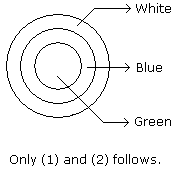
Statements: All the goats are tigers. All the tigers are lions.Conclusions: - All the goats are lions.
- All the lions are goats.
- Some lions are goats.
- Some tigers are goats.
- a)Only (1), (2) and (3)
- b)Only (1), (3) and (4)
- c)Only (2), (3) and (4)
- d)All the four
Correct answer is option 'B'. Can you explain this answer?
Statements: All the goats are tigers. All the tigers are lions.
Conclusions:
- All the goats are lions.
- All the lions are goats.
- Some lions are goats.
- Some tigers are goats.
a)
Only (1), (2) and (3)
b)
Only (1), (3) and (4)
c)
Only (2), (3) and (4)
d)
All the four

|
Tarun Nambiar answered |
Directions to Solve In each of the following questions two statements are given and these statements are followed by two conclusions numbered (1) and (2). You have to take the given two statements to be true even if they seem to be at variance from commonly known facts. Read the conclusions and then decide which of the given conclusions logically follows from the two given statements, disregarding commonly known facts.Give answer: - (A) If only (1) conclusion follows
- (B) If sonly (2) conclusion follows
- (C) If either (1) or (2) follows
- (D) If neither (1) nor (2) follows and
- (E) If both (1) and (2) follow.
Question - Statements: Some papers are pens. All the pencils are pens. Conclusions: - Some pens are pencils.
- Some pens are papers.
- a)Only (1) conclusion follows
- b)Only (2) conclusion follows
- c)Either (1) or (2) follows
- d)Neither (1) nor (2) follows
- e)Both (1) and (2) follow
Correct answer is option 'E'. Can you explain this answer?
Directions to Solve
In each of the following questions two statements are given and these statements are followed by two conclusions numbered (1) and (2). You have to take the given two statements to be true even if they seem to be at variance from commonly known facts. Read the conclusions and then decide which of the given conclusions logically follows from the two given statements, disregarding commonly known facts.
Give answer:
- (A) If only (1) conclusion follows
- (B) If sonly (2) conclusion follows
- (C) If either (1) or (2) follows
- (D) If neither (1) nor (2) follows and
- (E) If both (1) and (2) follow.
Statements: Some papers are pens. All the pencils are pens.
Conclusions:
- Some pens are pencils.
- Some pens are papers.
a)
Only (1) conclusion follows
b)
Only (2) conclusion follows
c)
Either (1) or (2) follows
d)
Neither (1) nor (2) follows
e)
Both (1) and (2) follow

|
Swati Singh answered |
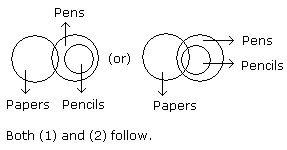
In the following question below are given some statements followed by some conclusions based on those statements. Taking the given statements to be true even if they seem to be at variance from commonly known facts. Read all the conclusions and then decide which of the given conclusion logically follows the given statements.Statements:I. All B are V.II. All K are B.Conclusion:I. All K are V.II. No V is B.- a)Both conclusions I and II follows
- b)Neither conclusion follows
- c)Only conclusion I follows
- d)Only conclusion II follows
Correct answer is option 'C'. Can you explain this answer?
In the following question below are given some statements followed by some conclusions based on those statements. Taking the given statements to be true even if they seem to be at variance from commonly known facts. Read all the conclusions and then decide which of the given conclusion logically follows the given statements.
Statements:
I. All B are V.
II. All K are B.
Conclusion:
I. All K are V.
II. No V is B.
a)
Both conclusions I and II follows
b)
Neither conclusion follows
c)
Only conclusion I follows
d)
Only conclusion II follows
|
|
Muskaan dasgupta answered |
Given Statements:
I. All B are V.
II. All K are B.
Conclusion:
I. All K are V.
II. No V is B.
Explanation:
In the given statements, it is mentioned that all B are V (I) and all K are B (II). Based on these statements, we can logically deduce the following:
Conclusion I: All K are V
Since all B are V and all K are B, it implies that all K are also V. This conclusion logically follows from the given statements.
Conclusion II: No V is B
This conclusion does not follow from the given statements. It is possible for some B to be V as per the first statement "All B are V".
Therefore, the correct answer is option C) Only conclusion I follows.
I. All B are V.
II. All K are B.
Conclusion:
I. All K are V.
II. No V is B.
Explanation:
In the given statements, it is mentioned that all B are V (I) and all K are B (II). Based on these statements, we can logically deduce the following:
Conclusion I: All K are V
Since all B are V and all K are B, it implies that all K are also V. This conclusion logically follows from the given statements.
Conclusion II: No V is B
This conclusion does not follow from the given statements. It is possible for some B to be V as per the first statement "All B are V".
Therefore, the correct answer is option C) Only conclusion I follows.
Read the given statements and conclusions carefully. Assuming that the information given in the statements is true, even if it appears to be at variance with commonly known facts, decide which of the given conclusions logically follow(s) from the statements.Statements:Some jugs are bottles.
No bottle is a candy.
All spoons are bottles.Conclusions:I. Some jugs are spoons.
Il. No spoon is a candy.
Ill. No jug is a spoon.
IV. No jug is a candy.- a)Either Conclusion I or Ill and II follow.
- b)Only Conclusions Il and III follow.
- c)Only Conclusions I, Il and IV follow.
- d)Either Conclusion I or IV and II follow.
Correct answer is option 'A'. Can you explain this answer?
Read the given statements and conclusions carefully. Assuming that the information given in the statements is true, even if it appears to be at variance with commonly known facts, decide which of the given conclusions logically follow(s) from the statements.
Statements:
Some jugs are bottles.
No bottle is a candy.
All spoons are bottles.
No bottle is a candy.
All spoons are bottles.
Conclusions:
I. Some jugs are spoons.
Il. No spoon is a candy.
Ill. No jug is a spoon.
IV. No jug is a candy.
Il. No spoon is a candy.
Ill. No jug is a spoon.
IV. No jug is a candy.
a)
Either Conclusion I or Ill and II follow.
b)
Only Conclusions Il and III follow.
c)
Only Conclusions I, Il and IV follow.
d)
Either Conclusion I or IV and II follow.

|
EduRev CLAT answered |
The least possible diagram for the given statements is as follows
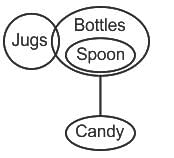
Conclusion:
I. Some jugs are spoons → False → (As Some jugs are bottles and all spoons are bottles, So some spoon are jugs is possibility but not definite)
II. No spoon is a candy → True → (As all spoons are candy and No bottle is candy, So no spoon is candy is definite true)
III. No jug is a spoon → False → (As some jugs are bottles and all spoons are bottles, So No jug is a spoon is a possibility but not definite)
IV. No jug is a candy → False → (As some jugs are bottles and no bottles are candy, So No jug is candy is it is possible but not definite)
Hence, the correct answer is "Either Conclusion I or III and II follow".
Read the given statements and conclusions carefully. Assuming that the information given in the statements is true, even if it appears to be at variance with commonly known facts, decide which of the given conclusions logically follow(s) from the statements.Statements:All tigers are lions.All lions are animals.Conclusions:Ⅰ. All tigers are animals.Ⅱ. No tigers is a bird. - a)Only conclusion II follows
- b)Both the conclusions follow
- c)Either conclusion I or II follows
- d)Only conclusion I follows
Correct answer is option 'D'. Can you explain this answer?
Read the given statements and conclusions carefully. Assuming that the information given in the statements is true, even if it appears to be at variance with commonly known facts, decide which of the given conclusions logically follow(s) from the statements.
Statements:
All tigers are lions.
All lions are animals.
Conclusions:
Ⅰ. All tigers are animals.
Ⅱ. No tigers is a bird.
a)
Only conclusion II follows
b)
Both the conclusions follow
c)
Either conclusion I or II follows
d)
Only conclusion I follows

|
EduRev CLAT answered |
The least possible Venn diagram is:
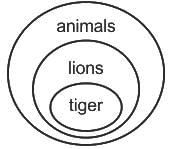
Conclusions:
Ⅰ. All tigers are animals. → Follows (As, All tigers are lions and All lions are animals)
Ⅱ. No tigers is a bird. → Do not follow (As, bird is not given in the statement, the relation between bird and tiger cannot be determined)
Hence, only conclusion I follows.
Statements: Some pens are books. Some books are pencils.Conclusions: - Some pens are pencils.
- Some pencils are pens.
- All pencils are pens.
- All books are pens.
- a)Only (1) and (3)
- b)Only (2) and (4)
- c)Only (1)
- d)All the four
- e)None of the four
Correct answer is option 'E'. Can you explain this answer?
Statements: Some pens are books. Some books are pencils.
Conclusions:
- Some pens are pencils.
- Some pencils are pens.
- All pencils are pens.
- All books are pens.
a)
Only (1) and (3)
b)
Only (2) and (4)
c)
Only (1)
d)
All the four
e)
None of the four

|
Shivam Menon answered |
Statements:
All apples are fruits.
All fruits are healthy.Conclusions:
1. Some apples are healthy.
2. All apples are healthy.
3. Some healthy things are fruits.
4. Some fruits are apples.- a)Only (2) and (3)
- b)Only (1), (2), and (4)
- c)Only (1), (2), and (3)
- d)All the four
Correct answer is option 'D'. Can you explain this answer?
Statements:
All apples are fruits.
All fruits are healthy.
All apples are fruits.
All fruits are healthy.
Conclusions:
1. Some apples are healthy.
2. All apples are healthy.
3. Some healthy things are fruits.
4. Some fruits are apples.
1. Some apples are healthy.
2. All apples are healthy.
3. Some healthy things are fruits.
4. Some fruits are apples.
a)
Only (2) and (3)
b)
Only (1), (2), and (4)
c)
Only (1), (2), and (3)
d)
All the four

|
Shalini Kumar answered |
Understanding the Statements
The statements provided are:
- All apples are fruits.
- All fruits are healthy.
From these statements, let's analyze the conclusions drawn.
Analysis of Conclusions
1. Conclusion 1: Some apples are healthy.
- Since all apples are fruits and all fruits are healthy, it logically follows that some apples must also be healthy. This conclusion is valid.
2. Conclusion 2: All apples are healthy.
- Again, since every apple falls under the category of fruits, and all fruits are healthy, it can be concluded that all apples are indeed healthy. This conclusion is also valid.
3. Conclusion 3: Some healthy things are fruits.
- Since all fruits are classified as healthy, it follows that some of the healthy things must be fruits. Therefore, this conclusion is valid.
4. Conclusion 4: Some fruits are apples.
- Given that all apples belong to the larger category of fruits, it can be concluded that there are indeed some fruits (specifically, apples) among all the fruits. This conclusion is valid.
Final Verdict
Since all four conclusions logically follow from the initial statements, the correct answer is:
Option D: All the four conclusions are valid.
Each conclusion is supported by the inherent relationships established in the statements, reinforcing the interconnectedness of apples, fruits, and health.
The statements provided are:
- All apples are fruits.
- All fruits are healthy.
From these statements, let's analyze the conclusions drawn.
Analysis of Conclusions
1. Conclusion 1: Some apples are healthy.
- Since all apples are fruits and all fruits are healthy, it logically follows that some apples must also be healthy. This conclusion is valid.
2. Conclusion 2: All apples are healthy.
- Again, since every apple falls under the category of fruits, and all fruits are healthy, it can be concluded that all apples are indeed healthy. This conclusion is also valid.
3. Conclusion 3: Some healthy things are fruits.
- Since all fruits are classified as healthy, it follows that some of the healthy things must be fruits. Therefore, this conclusion is valid.
4. Conclusion 4: Some fruits are apples.
- Given that all apples belong to the larger category of fruits, it can be concluded that there are indeed some fruits (specifically, apples) among all the fruits. This conclusion is valid.
Final Verdict
Since all four conclusions logically follow from the initial statements, the correct answer is:
Option D: All the four conclusions are valid.
Each conclusion is supported by the inherent relationships established in the statements, reinforcing the interconnectedness of apples, fruits, and health.
Read the given statements and conclusions carefully. Assuming that the information given in the statements is true, even if it appears to be at variance with commonly known facts, decide which of the given conclusions logically follow(s) from the statements.Statements: I. Some X are M.II. All W are X.Conclusions:I. Some M are not W.II. No W is M.III. Some M are not X.- a)None of the conclusions follow
- b)Only conclusion III follows
- c)Only conclusions II and III follow
- d)All the conclusions follow
Correct answer is option 'A'. Can you explain this answer?
Read the given statements and conclusions carefully. Assuming that the information given in the statements is true, even if it appears to be at variance with commonly known facts, decide which of the given conclusions logically follow(s) from the statements.
Statements:
I. Some X are M.
II. All W are X.
Conclusions:
I. Some M are not W.
II. No W is M.
III. Some M are not X.
a)
None of the conclusions follow
b)
Only conclusion III follows
c)
Only conclusions II and III follow
d)
All the conclusions follow

|
EduRev CLAT answered |
The least possible Venn diagram for the given statements is as shown below :

Conclusions:
I. Some M are not W → Does not follow (As some X are M, all W are X. So, it is possible but not definitely true)
II. No W is M → Does not follow (As all W are X, some X are M. So,it is possible but not definitely true)
III. Some M are not X → Does not follow (As some X are M. So, it is possible but not definitely true)
∴ Here, None of the conclusions follow.
Hence, the correct answer is "None of the conclusions follow".
Directions to SolveIn each of the following questions there are three statements. Which are followed by three or four conclusions. Choose the conclusions which logically follow from the given statements.Question - Statements: - All the locks are keys.
- All the keys are bats.
- Some watches are bats.
Conclusions: - Some bats are locks.
- Some watches are keys.
- All the keys are locks.
- a)Only (1) and (2)
- b)Only (1)
- c)Only (2)
- d)Only (1) and (3)
Correct answer is option 'B'. Can you explain this answer?
Directions to Solve
In each of the following questions there are three statements. Which are followed by three or four conclusions. Choose the conclusions which logically follow from the given statements.
Question -
Statements:
- All the locks are keys.
- All the keys are bats.
- Some watches are bats.
Conclusions:
- Some bats are locks.
- Some watches are keys.
- All the keys are locks.
a)
Only (1) and (2)
b)
Only (1)
c)
Only (2)
d)
Only (1) and (3)

|
EduRev CAT answered |
Upon examining the statements and conclusions provided, it is clear that the conclusion "(1) Some bats are locks" logically follows from the given statements because if all locks are keys and all keys are bats, then some bats must indeed be locks.
Conclusion "(2) Some watches are keys" does not follow because there is no direct link between watches and keys in the statements.
Conclusion "(3) All the keys are locks" is incorrect because it contradicts the given statement that "All locks are keys."
Therefore, the correct conclusion is indeed "(1) Some bats are locks," making the correct option "Only (1)."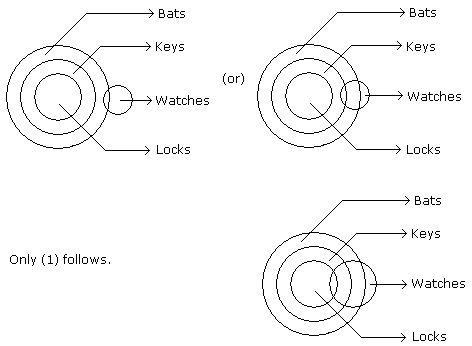

Directions to Solve In each of the following questions there are three statements. Which are followed by three or four conclusions. Choose the conclusions which logically follow from the given statements. Question - Statements: Some envelops are gums. Some gums are seals. Some seals are adhesives. Conclusions: - Some envelopes are seals.
- Some gums are adhesives.
- Some adhesives are seals.
- Some adhesives are gums.
- a)Only (3)
- b)Only (1)
- c)Only (2)
- d)Only (4)
Correct answer is option 'A'. Can you explain this answer?
Directions to Solve
In each of the following questions there are three statements. Which are followed by three or four conclusions. Choose the conclusions which logically follow from the given statements.
Question - Statements: Some envelops are gums. Some gums are seals. Some seals are adhesives.
Conclusions:
- Some envelopes are seals.
- Some gums are adhesives.
- Some adhesives are seals.
- Some adhesives are gums.
a)
Only (3)
b)
Only (1)
c)
Only (2)
d)
Only (4)

|
Varun Rane answered |
Understanding the Statements
The statements provided are:
- Some envelopes are gums.
- Some gums are seals.
- Some seals are adhesives.
These statements indicate relationships among four categories: envelopes, gums, seals, and adhesives.
Analyzing the Conclusions
Now, let’s analyze each conclusion based on the statements:
- Conclusion 1: Some envelopes are seals.
- This conclusion cannot be directly inferred. We know some envelopes are gums and some gums are seals, but we cannot conclude that some envelopes are seals as there may be no direct connection.
- Conclusion 2: Some gums are adhesives.
- This conclusion is also not valid. Although some gums are seals and some seals are adhesives, there is no direct indication that any gums are adhesives.
- Conclusion 3: Some adhesives are seals.
- This conclusion logically follows from the statements. Since some seals are adhesives, it is valid to say that some adhesives are indeed seals.
- Conclusion 4: Some adhesives are gums.
- Similar to conclusion 2, this cannot be concluded. There is no direct relationship established that connects adhesives to gums.
Final Evaluation
Based on the analysis:
- Valid Conclusion:
- Only conclusion 3 ("Some adhesives are seals") logically follows from the given statements.
Thus, the correct answer is option 'A' (Only 3), as it is the only conclusion that can be derived directly from the statements provided.
The statements provided are:
- Some envelopes are gums.
- Some gums are seals.
- Some seals are adhesives.
These statements indicate relationships among four categories: envelopes, gums, seals, and adhesives.
Analyzing the Conclusions
Now, let’s analyze each conclusion based on the statements:
- Conclusion 1: Some envelopes are seals.
- This conclusion cannot be directly inferred. We know some envelopes are gums and some gums are seals, but we cannot conclude that some envelopes are seals as there may be no direct connection.
- Conclusion 2: Some gums are adhesives.
- This conclusion is also not valid. Although some gums are seals and some seals are adhesives, there is no direct indication that any gums are adhesives.
- Conclusion 3: Some adhesives are seals.
- This conclusion logically follows from the statements. Since some seals are adhesives, it is valid to say that some adhesives are indeed seals.
- Conclusion 4: Some adhesives are gums.
- Similar to conclusion 2, this cannot be concluded. There is no direct relationship established that connects adhesives to gums.
Final Evaluation
Based on the analysis:
- Valid Conclusion:
- Only conclusion 3 ("Some adhesives are seals") logically follows from the given statements.
Thus, the correct answer is option 'A' (Only 3), as it is the only conclusion that can be derived directly from the statements provided.
Directions to Solve
In each of the following questions there are three statements. Which are followed by three or four conclusions. Choose the conclusions which logically follow from the given statements.
Question -
Statements: All the papers are books. All the bags are books. Some purses are bags.
Conclusions:
- Some papers are bags.
- Some books are papers.
- Some books are purses.
- a)Only (1)
- b)Only (2) and (3)
- c)Only (1) and (2)
- d)Only (1) and (3)
Correct answer is option 'B'. Can you explain this answer?
Directions to Solve
In each of the following questions there are three statements. Which are followed by three or four conclusions. Choose the conclusions which logically follow from the given statements.
Question -
Statements: All the papers are books. All the bags are books. Some purses are bags.
Conclusions:
- Some papers are bags.
- Some books are papers.
- Some books are purses.
a)
Only (1)
b)
Only (2) and (3)
c)
Only (1) and (2)
d)
Only (1) and (3)

|
Mrinalini Basu answered |
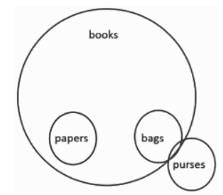
I. Some papers are bags→ it’s false.
II. Some books are papers→ it is definite hence it’s true.
III. Some books are purses → it is definite hence it’s true.
Hence only conclusion II and III follow.
Statements:
No tree is an animal.
Some animals are humans.Conclusions:
1. Some trees are humans.
2. No animal is a tree.
3. Some humans are not trees.
4. All animals are humans.- a)Only (2)
- b)Only (1) and (4)
- c)Only (2) and (3)
- d)None of the four
Correct answer is option 'A'. Can you explain this answer?
Statements:
No tree is an animal.
Some animals are humans.
No tree is an animal.
Some animals are humans.
Conclusions:
1. Some trees are humans.
2. No animal is a tree.
3. Some humans are not trees.
4. All animals are humans.
1. Some trees are humans.
2. No animal is a tree.
3. Some humans are not trees.
4. All animals are humans.
a)
Only (2)
b)
Only (1) and (4)
c)
Only (2) and (3)
d)
None of the four

|
EduRev CAT answered |
From the first statement, "No tree is an animal" ⇒ "No animal is a tree" (converse) ⇒ (2) follows.
No relation between trees and humans ⇒ (1) and (3) do not follow.
No support for (4).
So Option A is correct
No relation between trees and humans ⇒ (1) and (3) do not follow.
No support for (4).
So Option A is correct
In the following question below are given some statements followed by some conclusions based on those statements Taking the given statements to be true even if they seem to be at variance from commonly known facts. Read all the conclusions and then decide which of the given conclusion logically follows the given statements.Statements:I. All Z are Y.II. Some Y are B.Conclusion:I. Some B are not Z.II. Some Y are not Z.III. Some Z are Y. - a)Both conclusions II and III follows
- b)Both conclusions I and III follows
- c)Only conclusion III follows
- d)All conclusion follows
Correct answer is option 'C'. Can you explain this answer?
In the following question below are given some statements followed by some conclusions based on those statements Taking the given statements to be true even if they seem to be at variance from commonly known facts. Read all the conclusions and then decide which of the given conclusion logically follows the given statements.
Statements:
I. All Z are Y.
II. Some Y are B.
Conclusion:
I. Some B are not Z.
II. Some Y are not Z.
III. Some Z are Y.
a)
Both conclusions II and III follows
b)
Both conclusions I and III follows
c)
Only conclusion III follows
d)
All conclusion follows

|
Elite Coaching Classes answered |
Statements:
- All Z are Y: This means every Z is contained within Y.
- Some Y are B: This means there is at least some overlap between Y and B.
Conclusions:
- Some B are not Z:
- From the statements, there is no direct evidence that some B are not Z. While we know "Some Y are B" and "All Z are Y," this does not establish anything about the relationship between B and Z. Hence, this conclusion does not follow.
- Some Y are not Z:
- From the statement "All Z are Y," it follows that Z is entirely contained within Y. However, nothing in the statements suggests that some Y are not Z. This conclusion does not follow.
- Some Z are Y:
- From the statement "All Z are Y," it is clear that all Z are Y, so "Some Z are Y" is logically true as it is part of "all." Hence, this conclusion follows.
c) Only conclusion III follows.
Directions to Solve In each of the following questions there are three statements. Which are followed by three or four conclusions. Choose the conclusions which logically follow from the given statements. Question - Statements: Some keys are staplers. Some staplers are stickers. All the stickers are pens. Conclusions: - Some pens are staplers.
- Some stickers are keys.
- No sticker is key.
- Some staplers are keys.
- a)Only (1) and (2)
- b)Only (2) and (4)
- c)Only (2) and (3)
- d)Only (1) and (4) and either (2) or (3)
Correct answer is option 'D'. Can you explain this answer?
Directions to Solve
In each of the following questions there are three statements. Which are followed by three or four conclusions. Choose the conclusions which logically follow from the given statements.
Question - Statements: Some keys are staplers. Some staplers are stickers. All the stickers are pens.
Conclusions:
- Some pens are staplers.
- Some stickers are keys.
- No sticker is key.
- Some staplers are keys.
a)
Only (1) and (2)
b)
Only (2) and (4)
c)
Only (2) and (3)
d)
Only (1) and (4) and either (2) or (3)

|
Debanshi Saha answered |
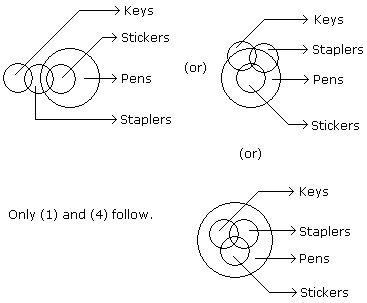
Three statements are given followed by two conclusions numbered I and II. Assuming the statements to be true, even if they seem to be at variance with commonly known facts, decide which of the conclusions logically follow(s) from the statements.Statements:All birds are crows.Some crows are parrots.No crow is a pigeon.Conclusions:I. No parrot is a pigeon.II. Some birds are parrots.- a)Only conclusion I follows
- b)Only conclusion II follows
- c)Neither conclusion I nor II follows
- d)Both conclusions I and II follow
Correct answer is option 'C'. Can you explain this answer?
Three statements are given followed by two conclusions numbered I and II. Assuming the statements to be true, even if they seem to be at variance with commonly known facts, decide which of the conclusions logically follow(s) from the statements.
Statements:
All birds are crows.
Some crows are parrots.
No crow is a pigeon.
Conclusions:
I. No parrot is a pigeon.
II. Some birds are parrots.
a)
Only conclusion I follows
b)
Only conclusion II follows
c)
Neither conclusion I nor II follows
d)
Both conclusions I and II follow

|
EduRev CLAT answered |
Given Statements:
All birds are crows.
Some crows are parrots.
No crow is a pigeon.
The least possible Venn diagram for the given statement is:
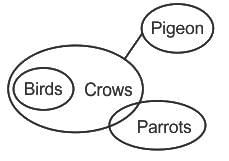
Conclusions:
I. No parrot is a pigeon - False (Because, No definite relation given between parrot and pigeon, so it can be possibly only).
II. Some birds are parrots - False (Because, No definite relation given between birds and parrots, so it can be possibly only).
So, Neither conclusion I nor II follows.
Hence, the correct answer is "Option 3".
Directions to Solve In each of the following questions there are three statements. Which are followed by three or four conclusions. Choose the conclusions which logically follow from the given statements. Question - Statements: Some rats are cats. Some cats are dogs. No dog is cow. Conclusions: - No cow is cat.
- No dog is rat.
- Some cats are rats.
- a)Only (1)
- b)Only (1) and (2)
- c)Only (1) and (3)
- d)Only (2) and (3)
- e)Only (3)
Correct answer is option 'E'. Can you explain this answer?
Directions to Solve
In each of the following questions there are three statements. Which are followed by three or four conclusions. Choose the conclusions which logically follow from the given statements.
Question - Statements: Some rats are cats. Some cats are dogs. No dog is cow.
Conclusions:
- No cow is cat.
- No dog is rat.
- Some cats are rats.
a)
Only (1)
b)
Only (1) and (2)
c)
Only (1) and (3)
d)
Only (2) and (3)
e)
Only (3)

|
Debanshi Saha answered |
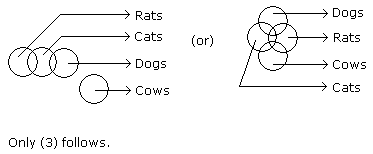
Directions to Solve In each of the following questions there are three statements. Which are followed by three or four conclusions. Choose the conclusions which logically follow from the given statements. Question - Statements: All the books are papers. Some papers are journals. Some journals are calendars. Conclusions: - Some journals are books.
- Some calendars are papers.
- Some books are journals.
- Some books are calendars.
- a)Only (1)
- b)Only (2)
- c)Only (3)
- d)Only (4)
- e)None of the four
Correct answer is option 'E'. Can you explain this answer?
Directions to Solve
In each of the following questions there are three statements. Which are followed by three or four conclusions. Choose the conclusions which logically follow from the given statements.
Question - Statements: All the books are papers. Some papers are journals. Some journals are calendars.
Conclusions:
- Some journals are books.
- Some calendars are papers.
- Some books are journals.
- Some books are calendars.
a)
Only (1)
b)
Only (2)
c)
Only (3)
d)
Only (4)
e)
None of the four

|
Krithika Sengupta answered |
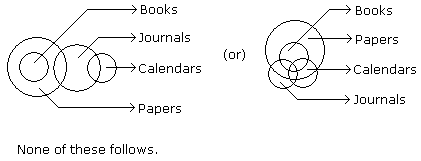
Directions to Solve In each of the following questions two statements are given and these statements are followed by two conclusions numbered (1) and (2). You have to take the given two statements to be true even if they seem to be at variance from commonly known facts. Read the conclusions and then decide which of the given conclusions logically follows from the two given statements, disregarding commonly known facts.Give answer: - (A) If only (1) conclusion follows
- (B) If sonly (2) conclusion follows
- (C) If either (1) or (2) follows
- (D) If neither (1) nor (2) follows and
- (E) If both (1) and (2) follow.
Question - Statements: Some dogs are bats. Some bats are cats. Conclusions: - Some dogs are cats.
- Some cats are dogs.
- a)Only (1) conclusion follows
- b)Only (2) conclusion follows
- c)Either (1) or (2) follows
- d)Neither (1) nor (2) follows
- e)Both (1) and (2) follow
Correct answer is option 'D'. Can you explain this answer?
Directions to Solve
In each of the following questions two statements are given and these statements are followed by two conclusions numbered (1) and (2). You have to take the given two statements to be true even if they seem to be at variance from commonly known facts. Read the conclusions and then decide which of the given conclusions logically follows from the two given statements, disregarding commonly known facts.
Give answer:
- (A) If only (1) conclusion follows
- (B) If sonly (2) conclusion follows
- (C) If either (1) or (2) follows
- (D) If neither (1) nor (2) follows and
- (E) If both (1) and (2) follow.
Statements: Some dogs are bats. Some bats are cats.
Conclusions:
- Some dogs are cats.
- Some cats are dogs.
a)
Only (1) conclusion follows
b)
Only (2) conclusion follows
c)
Either (1) or (2) follows
d)
Neither (1) nor (2) follows
e)
Both (1) and (2) follow

|
Dipika Dasgupta answered |
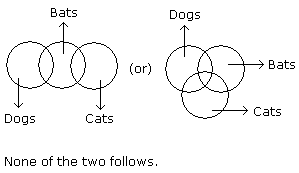
Directions to Solve In each of the following questions two statements are given. Which are followed by four conclusions (1), (2), (3) and (4). Choose the conclusions which logically follow from the given statements. Question - Statements: All the goats are tigers. All the tigers are lions. Conclusions: - All the goats are lions.
- All the lions are goats.
- Some lions are goats.
- Some tigers are goats.
- a)All the four
- b)Only (1), (2) and (3)
- c)Only (1), (3) and (4)
- d)Only (2), (3) and (4)
Correct answer is option 'C'. Can you explain this answer?
Directions to Solve
In each of the following questions two statements are given. Which are followed by four conclusions (1), (2), (3) and (4). Choose the conclusions which logically follow from the given statements.
Question - Statements: All the goats are tigers. All the tigers are lions.
Conclusions:
- All the goats are lions.
- All the lions are goats.
- Some lions are goats.
- Some tigers are goats.
a)
All the four
b)
Only (1), (2) and (3)
c)
Only (1), (3) and (4)
d)
Only (2), (3) and (4)

|
Rahul Gupta answered |
**Logical Reasoning: Statements and Conclusions**
**Statements:**
- All the goats are tigers.
- All the tigers are lions.
**Conclusions:**
1) All the goats are lions.
2) All the lions are goats.
3) Some lions are goats.
4) Some tigers are goats.
To determine which conclusions logically follow from the given statements, we need to analyze the information provided.
**Explanation:**
From the given statements, we can infer the following:
- All the goats are tigers. (Statement 1)
- All the tigers are lions. (Statement 2)
Based on these statements, we can draw the following conclusions:
**Conclusion 1: All the goats are lions.**
This conclusion cannot be logically inferred from the given statements because there is no direct relationship between goats and lions. The statements only establish a relationship between goats and tigers, and between tigers and lions. Therefore, conclusion 1 is not valid.
**Conclusion 2: All the lions are goats.**
This conclusion cannot be logically inferred from the given statements because there is no direct relationship between lions and goats. The statements only establish a relationship between goats and tigers, and between tigers and lions. Therefore, conclusion 2 is not valid.
**Conclusion 3: Some lions are goats.**
This conclusion can be logically inferred from the given statements. Since all the goats are tigers, and all the tigers are lions, it is possible for some lions to also be goats. Therefore, conclusion 3 is valid.
**Conclusion 4: Some tigers are goats.**
This conclusion can be logically inferred from the given statements. Since all the goats are tigers, it is possible for some tigers to also be goats. Therefore, conclusion 4 is valid.
Therefore, the conclusions that logically follow from the given statements are:
- Conclusion 3: Some lions are goats.
- Conclusion 4: Some tigers are goats.
Hence, the correct answer is option C: Only (1), (3), and (4).
**Statements:**
- All the goats are tigers.
- All the tigers are lions.
**Conclusions:**
1) All the goats are lions.
2) All the lions are goats.
3) Some lions are goats.
4) Some tigers are goats.
To determine which conclusions logically follow from the given statements, we need to analyze the information provided.
**Explanation:**
From the given statements, we can infer the following:
- All the goats are tigers. (Statement 1)
- All the tigers are lions. (Statement 2)
Based on these statements, we can draw the following conclusions:
**Conclusion 1: All the goats are lions.**
This conclusion cannot be logically inferred from the given statements because there is no direct relationship between goats and lions. The statements only establish a relationship between goats and tigers, and between tigers and lions. Therefore, conclusion 1 is not valid.
**Conclusion 2: All the lions are goats.**
This conclusion cannot be logically inferred from the given statements because there is no direct relationship between lions and goats. The statements only establish a relationship between goats and tigers, and between tigers and lions. Therefore, conclusion 2 is not valid.
**Conclusion 3: Some lions are goats.**
This conclusion can be logically inferred from the given statements. Since all the goats are tigers, and all the tigers are lions, it is possible for some lions to also be goats. Therefore, conclusion 3 is valid.
**Conclusion 4: Some tigers are goats.**
This conclusion can be logically inferred from the given statements. Since all the goats are tigers, it is possible for some tigers to also be goats. Therefore, conclusion 4 is valid.
Therefore, the conclusions that logically follow from the given statements are:
- Conclusion 3: Some lions are goats.
- Conclusion 4: Some tigers are goats.
Hence, the correct answer is option C: Only (1), (3), and (4).
Directions to Solve
In each of the following questions two statements are given and these statements are followed by two conclusions numbered (1) and (2). You have to take the given two statements to be true even if they seem to be at variance from commonly known facts. Read the conclusions and then decide which of the given conclusions logically follows from the two given statements, disregarding commonly known facts.
Give answer:
- (A) If only (1) conclusion follows
- (B) If only (2) conclusion follows
- (C) If either (1) or (2) follows
- (D) If neither (1) nor (2) follows and
- (E) If both (1) and (2) follow.
Question -
Statements: All cars are cats. All fans are cats.
Conclusions:
- All cars are fans.
- Some fans are cars.
- a)Only (1) conclusion follows
- b)Only (2) conclusion follows
- c)Either (1) or (2) follows
- d)Neither (1) nor (2) follows
- e)Both (1) and (2) follow
Correct answer is option 'D'. Can you explain this answer?
Directions to Solve
In each of the following questions two statements are given and these statements are followed by two conclusions numbered (1) and (2). You have to take the given two statements to be true even if they seem to be at variance from commonly known facts. Read the conclusions and then decide which of the given conclusions logically follows from the two given statements, disregarding commonly known facts.
Give answer:
- (A) If only (1) conclusion follows
- (B) If only (2) conclusion follows
- (C) If either (1) or (2) follows
- (D) If neither (1) nor (2) follows and
- (E) If both (1) and (2) follow.
Question -
Statements: All cars are cats. All fans are cats.
Conclusions:
- All cars are fans.
- Some fans are cars.
a)
Only (1) conclusion follows
b)
Only (2) conclusion follows
c)
Either (1) or (2) follows
d)
Neither (1) nor (2) follows
e)
Both (1) and (2) follow

|
Debolina Roy answered |
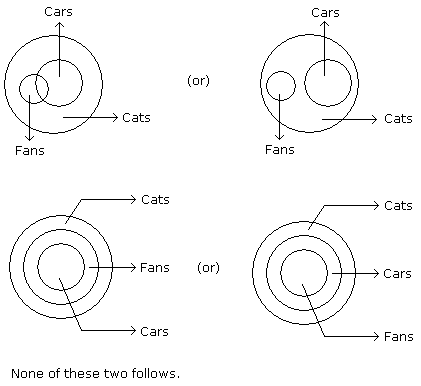
Reasoning:
- From the given statements, we know that both cars and fans are subsets of cats.
- However, there's no direct relationship established between cars and fans.
- We cannot conclude that all cars are fans (conclusion 1).
- Similarly, we cannot definitively say that some fans are cars (conclusion 2).
Therefore, neither conclusion follows logically from the given statements.
Answer: (D) Neither (1) nor (2) follows
Read the given statements and conclusions carefully. Assuming that the information given in the statements is true, even if it appears to be at variance with commonly known facts, decide which of the given conclusions logically follow(s) from the statements.Statements :Some jims are nests.
Some nests are beams.
All beams are coaches.Conclusions :I. Some coaches are nests.
II. Some beams are jims.
III. No beam is a jim.
IV. Some nests are jims.- a)Only conclusions I and II follow
- b)Only conclusions II and III follow
- c)Both conclusions I and IV and either conclusion II or III follow
- d)Only conclusions II and IV follow
Correct answer is option 'C'. Can you explain this answer?
Read the given statements and conclusions carefully. Assuming that the information given in the statements is true, even if it appears to be at variance with commonly known facts, decide which of the given conclusions logically follow(s) from the statements.
Statements :
Some jims are nests.
Some nests are beams.
All beams are coaches.
Some nests are beams.
All beams are coaches.
Conclusions :
I. Some coaches are nests.
II. Some beams are jims.
III. No beam is a jim.
IV. Some nests are jims.
II. Some beams are jims.
III. No beam is a jim.
IV. Some nests are jims.
a)
Only conclusions I and II follow
b)
Only conclusions II and III follow
c)
Both conclusions I and IV and either conclusion II or III follow
d)
Only conclusions II and IV follow
|
|
Pallavi bhatia answered |
Understanding the Statements
The statements provided can be analyzed to determine the relationships between the categories mentioned:
- Some jims are nests.
- Some nests are beams.
- All beams are coaches.
Analyzing the Conclusions
Let’s evaluate each conclusion based on the statements:
Conclusion I: Some coaches are nests.
- Since all beams are coaches and some nests are beams, it follows that some nests must also be coaches. Hence, this conclusion is valid.
Conclusion II: Some beams are jims.
- The statement indicates that some jims are nests and some nests are beams. However, it does not confirm that any beams are jims, so this conclusion cannot be confidently stated as valid. Thus, this conclusion is not necessarily true.
Conclusion III: No beam is a jim.
- The statements do not provide enough information to conclude that no beams are jims. Since some jims are nests and some nests are beams, it is possible (but not guaranteed) that some jims could be beams. Therefore, this conclusion is not valid.
Conclusion IV: Some nests are jims.
- Given that some jims are nests, it logically follows that some nests must be jims. Thus, this conclusion is valid.
Final Assessment
Based on the evaluations:
- Valid Conclusions: I and IV
- Not Valid Conclusions: II and III
Thus, the correct answer is option 'C': Both conclusions I and IV and either conclusion II or III follow.
The statements provided can be analyzed to determine the relationships between the categories mentioned:
- Some jims are nests.
- Some nests are beams.
- All beams are coaches.
Analyzing the Conclusions
Let’s evaluate each conclusion based on the statements:
Conclusion I: Some coaches are nests.
- Since all beams are coaches and some nests are beams, it follows that some nests must also be coaches. Hence, this conclusion is valid.
Conclusion II: Some beams are jims.
- The statement indicates that some jims are nests and some nests are beams. However, it does not confirm that any beams are jims, so this conclusion cannot be confidently stated as valid. Thus, this conclusion is not necessarily true.
Conclusion III: No beam is a jim.
- The statements do not provide enough information to conclude that no beams are jims. Since some jims are nests and some nests are beams, it is possible (but not guaranteed) that some jims could be beams. Therefore, this conclusion is not valid.
Conclusion IV: Some nests are jims.
- Given that some jims are nests, it logically follows that some nests must be jims. Thus, this conclusion is valid.
Final Assessment
Based on the evaluations:
- Valid Conclusions: I and IV
- Not Valid Conclusions: II and III
Thus, the correct answer is option 'C': Both conclusions I and IV and either conclusion II or III follow.
In the following question below are given some statements followed by some conclusions based on those statements. Taking the given statements to be true even if they seem to be at variance from commonly known facts. Read all the conclusions and then decide which of the given conclusion logically follows the given statements.Statements:I. No F is N.II. All N are L.Conclusions:I. All F are L.II. All N are F.III. Some L are N.- a)Only conclusion II follows
- b)Only conclusion III follows
- c)Only conclusion I follows
- d)All conclusion follows
Correct answer is option 'B'. Can you explain this answer?
In the following question below are given some statements followed by some conclusions based on those statements. Taking the given statements to be true even if they seem to be at variance from commonly known facts. Read all the conclusions and then decide which of the given conclusion logically follows the given statements.
Statements:
I. No F is N.
II. All N are L.
Conclusions:
I. All F are L.
II. All N are F.
III. Some L are N.
a)
Only conclusion II follows
b)
Only conclusion III follows
c)
Only conclusion I follows
d)
All conclusion follows

|
EduRev CLAT answered |
Given Statements:
I. No F is N.
II. All N are L.
The least possible Venn diagram for the given statement is:

Conclusions:
I. All F are L - False (Because, All N are L and no F is N, so those part of N that is L will be definitely not F).
II. All N are F - False (Because, No F is N).
III. Some L are N - True (Because, All N are L so, some L are N is definitely true).
So, Only conclusion III follows.
Hence, the correct answer is "Option 2".
Directions to Solve In each of the following questions two statements are given. Which are followed by four conclusions (1), (2), (3) and (4). Choose the conclusions which logically follow from the given statements. Question - Statements: All the research scholars are psychologists. Some psychologists are scientists. Conclusions: - All the research scholars are scientists.
- Some research scholars are scientists.
- Some scientists are psychologists.
- Some psychologists are research scholars.
- a)Only (3) and (4)
- b)None of the four
- c)All the four
- d)Only (3)
- e)Only (2) and (4)
Correct answer is option 'A'. Can you explain this answer?
Directions to Solve
In each of the following questions two statements are given. Which are followed by four conclusions (1), (2), (3) and (4). Choose the conclusions which logically follow from the given statements.
Question - Statements: All the research scholars are psychologists. Some psychologists are scientists.
Conclusions:
- All the research scholars are scientists.
- Some research scholars are scientists.
- Some scientists are psychologists.
- Some psychologists are research scholars.
a)
Only (3) and (4)
b)
None of the four
c)
All the four
d)
Only (3)
e)
Only (2) and (4)

|
Amar Iyer answered |
Solution:
The given statements are:
Statement 1: All the research scholars are psychologists.
Statement 2: Some psychologists are scientists.
We need to find the conclusions that logically follow from these statements. Let's analyze each conclusion one by one:
Conclusion 1: All the research scholars are scientists.
This conclusion cannot be logically derived from the given statements. Although some psychologists are scientists, it does not necessarily mean that all research scholars are scientists. Therefore, conclusion 1 does not follow.
Conclusion 2: Some research scholars are scientists.
This conclusion also cannot be logically derived from the given statements. While it is true that some psychologists are scientists, it does not guarantee that some research scholars are also scientists. Therefore, conclusion 2 does not follow.
Conclusion 3: Some scientists are psychologists.
This conclusion can be logically derived from the given statements. Statement 2 mentions that "Some psychologists are scientists," which implies that there is an overlapping between the two groups. Therefore, conclusion 3 follows.
Conclusion 4: Some psychologists are research scholars.
This conclusion can also be logically derived from the given statements. Statement 1 mentions that "All the research scholars are psychologists," which implies that there is at least some overlap between psychologists and research scholars. Therefore, conclusion 4 follows.
Based on the above analysis, the conclusions that logically follow from the given statements are:
- Conclusion 3: Some scientists are psychologists.
- Conclusion 4: Some psychologists are research scholars.
Therefore, the correct answer is option A: Only (3) and (4).
The given statements are:
Statement 1: All the research scholars are psychologists.
Statement 2: Some psychologists are scientists.
We need to find the conclusions that logically follow from these statements. Let's analyze each conclusion one by one:
Conclusion 1: All the research scholars are scientists.
This conclusion cannot be logically derived from the given statements. Although some psychologists are scientists, it does not necessarily mean that all research scholars are scientists. Therefore, conclusion 1 does not follow.
Conclusion 2: Some research scholars are scientists.
This conclusion also cannot be logically derived from the given statements. While it is true that some psychologists are scientists, it does not guarantee that some research scholars are also scientists. Therefore, conclusion 2 does not follow.
Conclusion 3: Some scientists are psychologists.
This conclusion can be logically derived from the given statements. Statement 2 mentions that "Some psychologists are scientists," which implies that there is an overlapping between the two groups. Therefore, conclusion 3 follows.
Conclusion 4: Some psychologists are research scholars.
This conclusion can also be logically derived from the given statements. Statement 1 mentions that "All the research scholars are psychologists," which implies that there is at least some overlap between psychologists and research scholars. Therefore, conclusion 4 follows.
Based on the above analysis, the conclusions that logically follow from the given statements are:
- Conclusion 3: Some scientists are psychologists.
- Conclusion 4: Some psychologists are research scholars.
Therefore, the correct answer is option A: Only (3) and (4).
Directions to Solve
In each of the following questions two statements are given and these statements are followed by two conclusions numbered (1) and (2). You have to take the given two statements to be true even if they seem to be at variance from commonly known facts. Read the conclusions and then decide which of the given conclusions logically follows from the two given statements, disregarding commonly known facts.
Give answer:
- (A) If only (1) conclusion follows
- (B) If sonly (2) conclusion follows
- (C) If either (1) or (2) follows
- (D) If neither (1) nor (2) follows and
- (E) If both (1) and (2) follow.
Question -
Statements: All buildings are chalks. No chalk is toffee.
Conclusions:
- No building is toffee
- All chalks are buildings.
- a)Only (1) conclusion follows
- b)Only (2) conclusion follows
- c)Either (1) or (2) follows
- d)Neither (1) nor (2) follows
- e)Both (1) and (2) follow
Correct answer is option 'A'. Can you explain this answer?
Directions to Solve
In each of the following questions two statements are given and these statements are followed by two conclusions numbered (1) and (2). You have to take the given two statements to be true even if they seem to be at variance from commonly known facts. Read the conclusions and then decide which of the given conclusions logically follows from the two given statements, disregarding commonly known facts.
Give answer:
- (A) If only (1) conclusion follows
- (B) If sonly (2) conclusion follows
- (C) If either (1) or (2) follows
- (D) If neither (1) nor (2) follows and
- (E) If both (1) and (2) follow.
Question -
Statements: All buildings are chalks. No chalk is toffee.
Conclusions:
- No building is toffee
- All chalks are buildings.
a)
Only (1) conclusion follows
b)
Only (2) conclusion follows
c)
Either (1) or (2) follows
d)
Neither (1) nor (2) follows
e)
Both (1) and (2) follow

|
Debanshi Saha answered |
Correct option is. Only (1) conclusion follows
Explanation: From the first statement "All buildings are chalks," we can infer that whatever is true for all chalks will also be true for all buildings. The second statement "No chalk is toffee" implies that there is no overlap between chalks and toffees.
Conclusion 1: "No building is toffee" logically follows because if no chalk is toffee and all buildings are chalks, then buildings cannot be toffees either.
Conclusion 2: "All chalks are buildings" does not logically follow. The first statement does not imply that all chalks must be buildings, only that all buildings are chalks. There could be chalks that are not buildings.
Statements:
Some fruits are mangos.
All mangos are guavas.
No guava is a banana.
Conclusions:
I. All guavas are fruits.
II. Some guavas are fruits- a)If only conclusion I follows.
- b)If only conclusion II follows.
- c)If either conclusion I or conclusion II follows
- d)If both conclusions I and II follows.
Correct answer is option 'B'. Can you explain this answer?
Statements:
Some fruits are mangos.
All mangos are guavas.
No guava is a banana.
Conclusions:
I. All guavas are fruits.
II. Some guavas are fruits
Some fruits are mangos.
All mangos are guavas.
No guava is a banana.
Conclusions:
I. All guavas are fruits.
II. Some guavas are fruits
a)
If only conclusion I follows.
b)
If only conclusion II follows.
c)
If either conclusion I or conclusion II follows
d)
If both conclusions I and II follows.

|
Tarun Nambiar answered |
(i) All pages are markers --> Universal Affirmative (A - type).
(ii) Some fruits are apples --> Particular Affirmative (I - type)
(iii)No book is a page --> Universal Negative (E - type).
(iv) Some books are not pages --> Particular Negative (O - type).
Some fruits are mangos.
All mangos are guavas.
I + A => I - type of conclusion
"Some fruits are guavas".
Conclusion II is Converse of it.
All mangos are guavas
No guava is a banana.
A + E => E - type of conclusion
"No mango is a banana"
(ii) Some fruits are apples --> Particular Affirmative (I - type)
(iii)No book is a page --> Universal Negative (E - type).
(iv) Some books are not pages --> Particular Negative (O - type).
Some fruits are mangos.
All mangos are guavas.
I + A => I - type of conclusion
"Some fruits are guavas".
Conclusion II is Converse of it.
All mangos are guavas
No guava is a banana.
A + E => E - type of conclusion
"No mango is a banana"
Answer Option B
Directions to Solve In each of the following questions two statements are given and these statements are followed by two conclusions numbered (1) and (2). You have to take the given two statements to be true even if they seem to be at variance from commonly known facts. Read the conclusions and then decide which of the given conclusions logically follows from the two given statements, disregarding commonly known facts.Give answer: - (A) If only (1) conclusion follows
- (B) If sonly (2) conclusion follows
- (C) If either (1) or (2) follows
- (D) If neither (1) nor (2) follows and
- (E) If both (1) and (2) follow.
Question - Statements: All the trucks are flies. Some scooters are flies. Conclusions: - All the trucks are scooters.
- Some scooters are trucks.
- a)Only (1) conclusion follows
- b)Only (2) conclusion follows
- c)Either (1) or (2) follows
- d)Neither (1) nor (2) follows
- e)Both (1) and (2) follow
Correct answer is option 'D'. Can you explain this answer?
Directions to Solve
In each of the following questions two statements are given and these statements are followed by two conclusions numbered (1) and (2). You have to take the given two statements to be true even if they seem to be at variance from commonly known facts. Read the conclusions and then decide which of the given conclusions logically follows from the two given statements, disregarding commonly known facts.
Give answer:
- (A) If only (1) conclusion follows
- (B) If sonly (2) conclusion follows
- (C) If either (1) or (2) follows
- (D) If neither (1) nor (2) follows and
- (E) If both (1) and (2) follow.
Statements: All the trucks are flies. Some scooters are flies.
Conclusions:
- All the trucks are scooters.
- Some scooters are trucks.
a)
Only (1) conclusion follows
b)
Only (2) conclusion follows
c)
Either (1) or (2) follows
d)
Neither (1) nor (2) follows
e)
Both (1) and (2) follow

|
Nandini Singh answered |
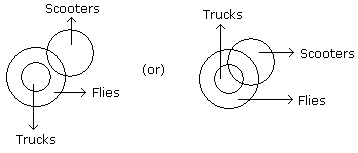
Neither (1) nor (2) follows.
Statement 1: Pictures can tell a story.
Statement 2: All storybooks have pictures.
Statement 3: Some storybooks have words.If the above statement are facts, then which of the following must also be a fact?
I. Pictures can tell a story better than words can.
II. The stories in storybook are very simple
III. Some storybooks have both words and pictures.- a)I only
- b)II only
- c)III only
- d)None of the statement is a known fact
Correct answer is option 'C'. Can you explain this answer?
Statement 1: Pictures can tell a story.
Statement 2: All storybooks have pictures.
Statement 3: Some storybooks have words.
Statement 2: All storybooks have pictures.
Statement 3: Some storybooks have words.
If the above statement are facts, then which of the following must also be a fact?
I. Pictures can tell a story better than words can.
II. The stories in storybook are very simple
III. Some storybooks have both words and pictures.
I. Pictures can tell a story better than words can.
II. The stories in storybook are very simple
III. Some storybooks have both words and pictures.
a)
I only
b)
II only
c)
III only
d)
None of the statement is a known fact

|
EduRev CLAT answered |
Answer: Option C
Since all storybooks have pictures and some storybooks have words, so some storybooks definitely have both words and pictures.
The other two conclusions cannot be derived from the statements.
Hence, option (c).
Directions to Solve In each of the following questions two statements are given and these statements are followed by two conclusions numbered (1) and (2). You have to take the given two statements to be true even if they seem to be at variance from commonly known facts. Read the conclusions and then decide which of the given conclusions logically follows from the two given statements, disregarding commonly known facts.Give answer: - (A) If only (1) conclusion follows
- (B) If sonly (2) conclusion follows
- (C) If either (1) or (2) follows
- (D) If neither (1) nor (2) follows and
- (E) If both (1) and (2) follow.
Question - Statements: Some mangoes are yellow. Some tixo are mangoes. Conclusions: - Some mangoes are green.
- Tixo is a yellow.
- a)Only (1) conclusion follows
- b)Only (2) conclusion follows
- c)Either (1) or (2) follows
- d)Neither (1) nor (2) follows
- e)Both (1) and (2) follow
Correct answer is option 'D'. Can you explain this answer?
Directions to Solve
In each of the following questions two statements are given and these statements are followed by two conclusions numbered (1) and (2). You have to take the given two statements to be true even if they seem to be at variance from commonly known facts. Read the conclusions and then decide which of the given conclusions logically follows from the two given statements, disregarding commonly known facts.
Give answer:
- (A) If only (1) conclusion follows
- (B) If sonly (2) conclusion follows
- (C) If either (1) or (2) follows
- (D) If neither (1) nor (2) follows and
- (E) If both (1) and (2) follow.
Statements: Some mangoes are yellow. Some tixo are mangoes.
Conclusions:
- Some mangoes are green.
- Tixo is a yellow.
a)
Only (1) conclusion follows
b)
Only (2) conclusion follows
c)
Either (1) or (2) follows
d)
Neither (1) nor (2) follows
e)
Both (1) and (2) follow

|
Debanshi Saha answered |
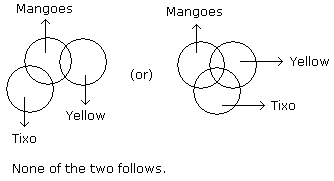
Directions to Solve In each of the following questions two statements are given and these statements are followed by two conclusions numbered (1) and (2). You have to take the given two statements to be true even if they seem to be at variance from commonly known facts. Read the conclusions and then decide which of the given conclusions logically follows from the two given statements, disregarding commonly known facts.Give answer: - (A) If only (1) conclusion follows
- (B) If sonly (2) conclusion follows
- (C) If either (1) or (2) follows
- (D) If neither (1) nor (2) follows and
- (E) If both (1) and (2) follow.
Question - Statements: All the harmoniums are instruments. All the instruments are flutes. Conclusions: - All the flutes are instruments.
- All the harmoniums are flutes.
- a)Only (1) conclusion follows
- b)Only (2) conclusion follows
- c)Either (1) or (2) follows
- d)Neither (1) nor (2) follows
- e)Both (1) and (2) follow
Correct answer is option 'B'. Can you explain this answer?
Directions to Solve
In each of the following questions two statements are given and these statements are followed by two conclusions numbered (1) and (2). You have to take the given two statements to be true even if they seem to be at variance from commonly known facts. Read the conclusions and then decide which of the given conclusions logically follows from the two given statements, disregarding commonly known facts.
Give answer:
- (A) If only (1) conclusion follows
- (B) If sonly (2) conclusion follows
- (C) If either (1) or (2) follows
- (D) If neither (1) nor (2) follows and
- (E) If both (1) and (2) follow.
Statements: All the harmoniums are instruments. All the instruments are flutes.
Conclusions:
- All the flutes are instruments.
- All the harmoniums are flutes.
a)
Only (1) conclusion follows
b)
Only (2) conclusion follows
c)
Either (1) or (2) follows
d)
Neither (1) nor (2) follows
e)
Both (1) and (2) follow

|
Krithika Sengupta answered |
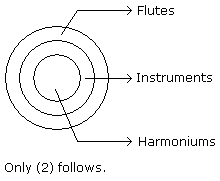
The statement below is followed by three outcomes numbered I, II and II. An outcome is either a step of administrative decision to be undertaken for improvement, or a follow-up for further action, or natural response by stakeholders, etc. on the basis of the information provided in the statement. Everything mentioned in the statement is to be assumed to be true, on the basis of which the most logically followed course of action has to be decided.Statement:The city council of Brownwood City has decided to install a plant of mineral water to provide the citizens mineral water bottles at US $ 1 per bottle as against bottles costing US $ 1.5 being sold by local private players.
I. All the local private companies selling bottled water in Brownwood City will have to close their operations.
II. The city council of Brownwood City will have to provide for the losses from this project in its budget.
III. The normal tap water supply of Brownwood City will have no takers and that will have to be discontinued.- a)None of I, II or III
- b)Only II
- c)Both II and III
- d)All I, II and III
Correct answer is option 'A'. Can you explain this answer?
The statement below is followed by three outcomes numbered I, II and II. An outcome is either a step of administrative decision to be undertaken for improvement, or a follow-up for further action, or natural response by stakeholders, etc. on the basis of the information provided in the statement. Everything mentioned in the statement is to be assumed to be true, on the basis of which the most logically followed course of action has to be decided.
Statement:
The city council of Brownwood City has decided to install a plant of mineral water to provide the citizens mineral water bottles at US $ 1 per bottle as against bottles costing US $ 1.5 being sold by local private players.
I. All the local private companies selling bottled water in Brownwood City will have to close their operations.
II. The city council of Brownwood City will have to provide for the losses from this project in its budget.
III. The normal tap water supply of Brownwood City will have no takers and that will have to be discontinued.
I. All the local private companies selling bottled water in Brownwood City will have to close their operations.
II. The city council of Brownwood City will have to provide for the losses from this project in its budget.
III. The normal tap water supply of Brownwood City will have no takers and that will have to be discontinued.
a)
None of I, II or III
b)
Only II
c)
Both II and III
d)
All I, II and III

|
Glance Learning Institute answered |
Answer: Option A
Outcome I does not follow; just because mineral water will be sold at a cheaper rate by the city council, this does not mean that all private companies selling bottled mineral water will close down altogether.
Outcome II does not follow; since their increased sales will probably more than make up for any losses incurred due to lower prices.
Outcome III does not follow; it is ludicrous to assume that people will be willing to do away with normal tap water just because mineral water is being sold at a somewhat reasonable rate.
Hence, the correct answer is option 1.
Outcome II does not follow; since their increased sales will probably more than make up for any losses incurred due to lower prices.
Outcome III does not follow; it is ludicrous to assume that people will be willing to do away with normal tap water just because mineral water is being sold at a somewhat reasonable rate.
Hence, the correct answer is option 1.
Directions to Solve In each of the following questions two statements are given and these statements are followed by two conclusions numbered (1) and (2). You have to take the given two statements to be true even if they seem to be at variance from commonly known facts. Read the conclusions and then decide which of the given conclusions logically follows from the two given statements, disregarding commonly known facts.Give answer: - (A) If only (1) conclusion follows
- (B) If sonly (2) conclusion follows
- (C) If either (1) or (2) follows
- (D) If neither (1) nor (2) follows and
- (E) If both (1) and (2) follow.
Question - Statements: Some actors are singers. All the singers are dancers. Conclusions: - Some actors are dancers.
- No singer is actor.
- a)Only (1) conclusion follows
- b)Only (2) conclusion follows
- c)Either (1) or (2) follows
- d)Neither (1) nor (2) follows
- e)Both (1) and (2) follow
Correct answer is option 'A'. Can you explain this answer?
Directions to Solve
In each of the following questions two statements are given and these statements are followed by two conclusions numbered (1) and (2). You have to take the given two statements to be true even if they seem to be at variance from commonly known facts. Read the conclusions and then decide which of the given conclusions logically follows from the two given statements, disregarding commonly known facts.
Give answer:
- (A) If only (1) conclusion follows
- (B) If sonly (2) conclusion follows
- (C) If either (1) or (2) follows
- (D) If neither (1) nor (2) follows and
- (E) If both (1) and (2) follow.
Statements: Some actors are singers. All the singers are dancers.
Conclusions:
- Some actors are dancers.
- No singer is actor.
a)
Only (1) conclusion follows
b)
Only (2) conclusion follows
c)
Either (1) or (2) follows
d)
Neither (1) nor (2) follows
e)
Both (1) and (2) follow

|
Nilanjan Kumar answered |
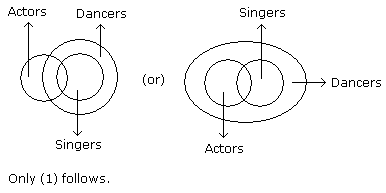
Directions to Solve In each of the following questions there are three statements. Which are followed by three or four conclusions. Choose the conclusions which logically follow from the given statements. Question - Statements: Some questions are answers. Some answers are writers. All the writers are poets. Conclusions: - Some writers are answers.
- Some poets are questions.
- All the questions are poets.
- Some poets are answers.
- a)Only (1) and (2)
- b)Only (1) and (4)
- c)Only (1) and (3)
- d)Only (2) and (4)
Correct answer is option 'B'. Can you explain this answer?
Directions to Solve
In each of the following questions there are three statements. Which are followed by three or four conclusions. Choose the conclusions which logically follow from the given statements.
Question - Statements: Some questions are answers. Some answers are writers. All the writers are poets.
Conclusions:
- Some writers are answers.
- Some poets are questions.
- All the questions are poets.
- Some poets are answers.
a)
Only (1) and (2)
b)
Only (1) and (4)
c)
Only (1) and (3)
d)
Only (2) and (4)

|
Sanaya Sharma answered |
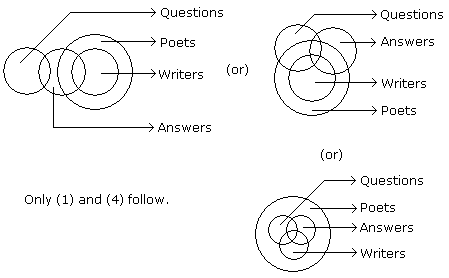
From the given statements, choose the conclusions which follow logically:Statements:
i. Some iphones are mobiles
ii. Some mobiles are ipads
iii. Some ipads are tablets
Conclusions:
I. Some tablets are iphones
II. Some mobiles are tablets
III.Some ipads are iphones
IV.All iphones are tablets- a)Both I and II
- b)Both II and III
- c)Both III and I
- d)None of A, B or C
Correct answer is option 'D'. Can you explain this answer?
From the given statements, choose the conclusions which follow logically:
Statements:
i. Some iphones are mobiles
ii. Some mobiles are ipads
iii. Some ipads are tablets
Conclusions:
I. Some tablets are iphones
II. Some mobiles are tablets
III.Some ipads are iphones
IV.All iphones are tablets
i. Some iphones are mobiles
ii. Some mobiles are ipads
iii. Some ipads are tablets
Conclusions:
I. Some tablets are iphones
II. Some mobiles are tablets
III.Some ipads are iphones
IV.All iphones are tablets
a)
Both I and II
b)
Both II and III
c)
Both III and I
d)
None of A, B or C

|
EduRev CLAT answered |
Answer: Option D
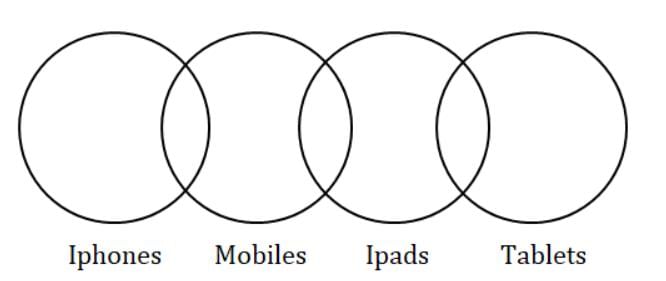
The statements i, ii and iii can be represented as shown above
From the figure, Set of iphones do not intersect with the set of ipads and the set of tablets, and the set of mobiles do not intersect with the set of tablets.
Consider the conclusions,
From the figure, first three conclusions are not true. In this set, the fourth conclusion cannot be concluded.
Hence, option (d).
Directions to Solve In each of the following questions two statements are given. Which are followed by four conclusions (1), (2), (3) and (4). Choose the conclusions which logically follow from the given statements. Question - Statements: All the phones are scales. All the scales are calculators. Conclusions: - All the calculators are scales.
- All the phones are calculators
- All the scales are phones.
- Some calculators are phones.
- a)Only (1) and (4)
- b)Only (3) and (4)
- c)Only (2) and (4)
- d)Only (1) and (2)
- e)Only (1) and (3)
Correct answer is option 'C'. Can you explain this answer?
Directions to Solve
In each of the following questions two statements are given. Which are followed by four conclusions (1), (2), (3) and (4). Choose the conclusions which logically follow from the given statements.
Question - Statements: All the phones are scales. All the scales are calculators.
Conclusions:
- All the calculators are scales.
- All the phones are calculators
- All the scales are phones.
- Some calculators are phones.
a)
Only (1) and (4)
b)
Only (3) and (4)
c)
Only (2) and (4)
d)
Only (1) and (2)
e)
Only (1) and (3)

|
Debanshi Saha answered |
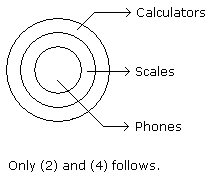
Directions to Solve
In each of the following questions two statements are given and these statements are followed by two conclusions numbered (1) and (2). You have to take the given two statements to be true even if they seem to be at variance from commonly known facts. Read the conclusions and then decide which of the given conclusions logically follows from the two given statements, disregarding commonly known facts.
Give answer:
- (A) If only (1) conclusion follows
- (B) If only (2) conclusion follows
- (C) If either (1) or (2) follows
- (D) If neither (1) nor (2) follows and
- (E) If both (1) and (2) follow.
Question -
Statements: Some ants are parrots. All the parrots are apples.
Conclusions:
- All the apples are parrots.
- Some ants are apples.
- a)Only (1) conclusion follows
- b)Only (2) conclusion follows
- c)Either (1) or (2) follows
- d)Neither (1) nor (2) follows
- e)Both (1) and (2) follow
Correct answer is option 'B'. Can you explain this answer?
Directions to Solve
In each of the following questions two statements are given and these statements are followed by two conclusions numbered (1) and (2). You have to take the given two statements to be true even if they seem to be at variance from commonly known facts. Read the conclusions and then decide which of the given conclusions logically follows from the two given statements, disregarding commonly known facts.
Give answer:
- (A) If only (1) conclusion follows
- (B) If only (2) conclusion follows
- (C) If either (1) or (2) follows
- (D) If neither (1) nor (2) follows and
- (E) If both (1) and (2) follow.
Question -
Statements: Some ants are parrots. All the parrots are apples.
Conclusions:
- All the apples are parrots.
- Some ants are apples.
a)
Only (1) conclusion follows
b)
Only (2) conclusion follows
c)
Either (1) or (2) follows
d)
Neither (1) nor (2) follows
e)
Both (1) and (2) follow

|
Arka Chakraborty answered |
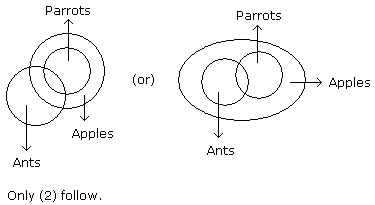
Let's analyze the statements and conclusions:
Statements:
- Some ants are parrots.
- All the parrots are apples.
Conclusions:
- All the apples are parrots.
- Some ants are apples.
Analysis:
-
From Statement 2, we know that "All the parrots are apples." This means that every parrot is indeed an apple, but not necessarily that every apple is a parrot.
-
From Statement 1, "Some ants are parrots," and knowing from Statement 2 that parrots are apples, it follows that some ants must be apples. This directly supports Conclusion 2.
-
Conclusion 1 states that "All the apples are parrots." However, Statement 2 only tells us that all parrots are apples, not that all apples are parrots. Hence, Conclusion 1 does not necessarily follow.
Therefore, the correct option is:
2. Only (2) conclusion follows
Chapter doubts & questions for Syllogism - IBPS PO Prelims & Mains Preparation 2025 is part of Bank Exams exam preparation. The chapters have been prepared according to the Bank Exams exam syllabus. The Chapter doubts & questions, notes, tests & MCQs are made for Bank Exams 2025 Exam. Find important definitions, questions, notes, meanings, examples, exercises, MCQs and online tests here.
Chapter doubts & questions of Syllogism - IBPS PO Prelims & Mains Preparation in English & Hindi are available as part of Bank Exams exam.
Download more important topics, notes, lectures and mock test series for Bank Exams Exam by signing up for free.
IBPS PO Prelims & Mains Preparation
670 videos|1101 docs|322 tests
|

Contact Support
Our team is online on weekdays between 10 AM - 7 PM
Typical reply within 3 hours
|
Free Exam Preparation
at your Fingertips!
Access Free Study Material - Test Series, Structured Courses, Free Videos & Study Notes and Prepare for Your Exam With Ease

 Join the 10M+ students on EduRev
Join the 10M+ students on EduRev
|

|
Create your account for free
OR
Forgot Password
OR
Signup to see your scores
go up
within 7 days!
within 7 days!
Takes less than 10 seconds to signup









